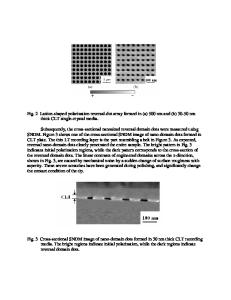Surface Potential Investigation on Nano Domain Formation in Lithium Tantalate Single Crystal
- PDF / 206,643 Bytes
- 6 Pages / 595 x 842 pts (A4) Page_size
- 74 Downloads / 254 Views
0902-T10-50.1
Surface Potential Investigation on Nano Domain Formation in Lithium Tantalate Single Crystal Mirai Katoh and Yasuo Cho Research Institute of Electrical Communication, Tohoku University 2-1-1 Katahira, Aoba-ku, Sendai, 980-8577, Japan ABSTRACT The surface potential distribution following polarization reversal by scanning probe microscopy is examined in order to determine the mechanism of anti-parallel polarization reversal and ring-shaped domain formation in single-crystal lithium tantalate. Lithium vacancy lattice defects are identified as charge-trapping sites, with the resultant surface potential distribution governing the formation of ring-shaped nano-domains. The behavior of this charge injection is shown to be dependent on atmospheric humidity.
INTRODUCTION Ferroelectric materials have attracted much interest for application in nonvolatile random access memory (NVRAM) due to the thinness of the domain walls compared to ferromagnetic materials. Scanning probe microscopy (SPM), an important technology in material research on the nanometer scale, can be used to induce the formation of very small ferroelectric domains by applying the sharp SPM tip (< 100 nm diameter) as a top electrode. Scanning nonlinear dielectric microscopy (SNDM) [1] and piezo-response force microscopy (PFM) [2], variants of the SPM technique, can be utilized to detect polarization domain distribution with high resolution. Detailed knowledge of such ferroelectric nano-domain formation is important in the development of systems that exploit small inverted domains. In these analyses, however, elusive phenomena such as anti-parallel polarization reversal and ring-shaped domain formation have been reported [3, 4, 5, 6] in association with lattice defects [5]. In this study, the surface potential distribution after polarization reversal is characterized by Kelvin probe force microscopy (KFM) [7] in order to clarify the detailed mechanism of ferroelectric polarization reversal.
0902-T10-50.2
EXPERIMENTS Experiment 1: lattice defects and charge injection A previous experiment comparing single crystals of thin congruent lithium tantalate (CLT) and thin stoichiometric lithium tantalate (SLT) has revealed that lattice defects are responsible for phenomena such as anti-parallel polarization reversal and ring-shaped domain formation [5]. In the present study, the surface potential distribution on SLT and CLT was observed before and after polarization reversal in order to clarify the details of ring-shaped domain formation. The same experimental setup was used to apply the electric field, measure the surface potential, and measure the polarization distribution. A gold-coated cantilever tip with radius of less than 30 nm was used in probe measurements. In the measurement procedure, a voltage was applied to the bottom electrode with the tip grounded. The surface potential distribution image was then obtained by KFM, and the polarization distribution was determined by SNDM. The electric field was applied as a 40 V pulse with 1 s duration. SL
Data Loading...











